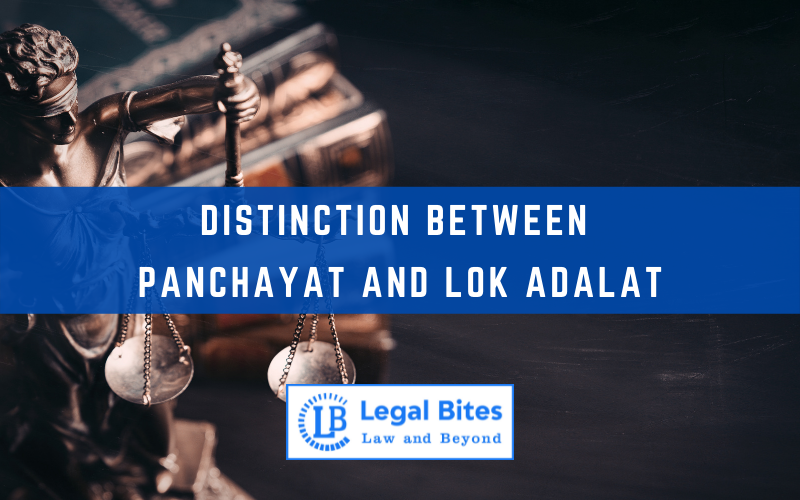Distinction Between Panchayat and Lok Adalat
This article discusses five major distinctions between Panchayat and Lok Adalat. Distinction Between Panchayat and Lok Adalat FIRST, A Panchayat is a full-fledged court that is established to entertain disputes of both civil and criminal nature. It collects and takes evidence and gives a decision on the case before it whereas Lok Adalat is not a full-fledged court, rather… Read More »

This article discusses five major distinctions between Panchayat and Lok Adalat. Distinction Between Panchayat and Lok Adalat FIRST, A Panchayat is a full-fledged court that is established to entertain disputes of both civil and criminal nature. It collects and takes evidence and gives a decision on the case before it whereas Lok Adalat is not a full-fledged court, rather it is an institution for handling disputes by conciliation. It aims at arriving at a settlement or compromise between...
This article discusses five major distinctions between Panchayat and Lok Adalat.
Distinction Between Panchayat and Lok Adalat
FIRST,
A Panchayat is a full-fledged court that is established to entertain disputes of both civil and criminal nature. It collects and takes evidence and gives a decision on the case before it whereas Lok Adalat is not a full-fledged court, rather it is an institution for handling disputes by conciliation. It aims at arriving at a settlement or compromise between the parties.
SECOND,
Panchayat decides the case on merit whereas Lok Adalat does not decide the case on merit except PLA.
THIRD,
A Panchayat would be a representative judicial body of all sections of the society within its jurisdictional territory Whereas a Lok Adalat is not a representative judicial body or committee. It is organised by appointments by the authorities under Legal Services Authority Act within their respective jurisdiction.
FOURTH,
A Panchayat has no power to summon witnesses to produce documents whereas Lok Adalat has been conferred powers for summoning witnesses, discovery and production of documents.
FIFTH,
A Panchayat can conciliate the parties and come to a compromise between them and order accordingly whereas A Lok Adalat acts as conciliator only when the parties come mutually to a compromise it shall pass a compromise decree.
Conclusion
In the working of the LSAA, it is clear that the major area of activity has been the organising of Lok Adalat on a periodical basis. While in many states, the authorities have laid down detailed provisions in the regulations for the holding of Lok Adalat, some states have seen this as a separate area for rulemaking.
The pattern, however, is largely similar in most states. In many respects, the Lok Adalat are planned as an activity closely linked to court proceedings. They are held within the Court premises and the ‘benches’ comprise adjudge, a lawyer and a social worker. A reference to the Lok Adalat can be made by any one of the parties to the litigation. There are no appeals from the decisions of the Lok Adalat that record a compromise. Lok Adalat can dispose of compoundable criminal cases.
The term ‘Lok Adalat is perhaps a misnomer since there is little involvement of the people in the actual decision-making process. This distinguishes Lok Adalat from the traditional modes of mediation and informal dispute resolution mechanisms. There have Iveu criticisms that the system of Lok Adalat does not address the concerns of the litigants for getting quality justice as much as it is seen as a device in caseload management by the judiciary.
This criticism points out that the reasons offered for persuading the litigant to participate in the Lok Adalat delay, prohibitive costs and uncertain results actually acknowledge the failure of the justice delivery system. Secondly, the legal aid institutions and legal aid lawyers are themselves part of the exercise of holding criminal courts inside jail premises. In sittings held periodically as part of the legal aid programme, petty criminal cases involving offences punishable with short sentences of three years and less are sought to be disposed of in bulk. At the hearing, legal aid lawyers appear for the accused but go along with the object of quick disposal of the cases by encouraging guilty pleas.
The prospect of immediate release after being sentenced to the period of detention already undergone is enough of an incentive for an accused to admit to guilt. The institutions of the LSAA thus help deal with the problem of pendency of criminal cases where the period of detention undergone by the accused without a trial can exceed the maximum sentence that would normally be awarded if the accused was convicted at the end of a trial. This manner of disposal does not answer the demand of the accused of a fair just and reasonable procedure but perhaps answers the need to preserve the legitimacy of the legal system that is beleaguered by lack of infrastructure and resources.

Mayank Shekhar
Mayank is an alumnus of the prestigious Faculty of Law, Delhi University. Under his leadership, Legal Bites has been researching and developing resources through blogging, educational resources, competitions, and seminars.

